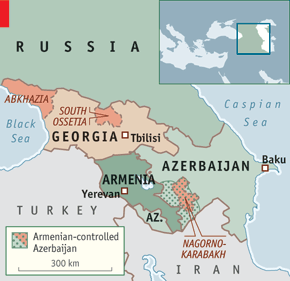Given all of the hullabaloo surrounding Russia’s plans to
begin flying its
bombers over the Gulf of Mexico and the movement
of Russian tanks, artillery, and combat troops into Ukraine, it is only too
easy to forget about the long-frozen conflicts of Eastern Europe and the
Caucasus. Faced with what could turn into a painfully hot (and, some argue, possibly
nuclear) fight in eastern Ukraine, the world can hardly be blamed for
dropping the 20 year-old disputes involving South Ossetia and Abkhazia,
Transnistria, or Nagorno-Karabakh in favor of this seemingly much more urgent
and dangerous clash.
That is not to say that ignoring these frozen conflicts is
an especially good idea, however. In particular, there appears to be a growing
chance that the dispute between Armenia and Azerbaijan over Nagorno-Karabakh
and the surrounding regions is thawing rapidly and may very well combust in the
relatively near future. On Wednesday, Azerbaijani forces shot
down a Mi-25 helicopter from the self-proclaimed “self-defense forces” of
Nagorno-Karabakh, reportedly killing three Armenian soldiers who were on board.
This is the first time an aircraft has been shot down since Russia brokered a
ceasefire in 1994. It also follows on the heels of the heaviest fighting the region has
seen in years, with clashes from July 28-Aug 3 that killed at least 25 and
wounded dozens more. While exchanges of fire are not uncommon, clashes this
year have been more intense and more frequent than usual.
Under the Soviet Union, the disputed territory was
designated an autonomous region within Soviet Azerbaijan. In the late 1980s,
its predominantly ethnic Armenian population sought to formally join Armenia,
triggering a 6-year
war of secession that began in
1988 and killed some 30,000 people before the aforementioned ceasefire was
negotiated and implemented. Although Nagorno-Karabakh unilaterally declared
independence in 1991 and is run by ethnic Armenians, it is legally part
of Azerbaijan and represents approximately 1/7 of the latter’s overall
territory. The CSCE (now the OSCE) created the Minsk
Group in 1992 (headed by France,
Russia, and the United States) to encourage and facilitate a peaceful and
negotiated resolution to the conflict, although their success has obviously
been somewhat limited.
One of the most frustrating aspects of this conflict – and
perhaps the primary reason that it remains unresolved 20+ years after it began
– is the fact that, in many ways, both Armenia and Azerbaijan have put the
possession of Nagorno-Karabakh at the center of their state-building efforts. Making
any sort of concessions or compromise would represent the betrayal of a sacred
national cause (see Thomas
De Waal’s The Caucasus: An Introduction
for more on this particular argument). Furthermore, the Caucasus as a whole has
long been of interest to Russia, in its tsarist, Soviet, and modern-day
incarnations. The Russian hand is thus often involved in the region, which may
further complicate efforts to resolve the situation
A question thus emerges: to what extent (if at all) can the
uptick in incidents (in terms of both number and intensity) be attributed to
Russian influence? Armenia is almost completely dependent on Russian military
support and highly subject to Russian economic influence (as illustrated by
its decision to join Moscow’s Customs Union). Some hypothesize that Russia’s
annexation of Crimea and support for separatists in eastern Ukraine encouraged the Armenians
to make another push for “reunification of Armenia’s historical lands” in the
expectation that Russia would support them as well (although whether they
stopped to verify the veracity of this belief seems unclear and even unlikely).
Russia also seemed to box out
its fellow Minsk Group co-chairs in bringing together the Armenian and
Azerbaijani leaders to put a halt to the outbreak of violence earlier this
summer. This gave it an opportunity to play peacemaker, but also to demonstrate
how little influence the West has over the conflict. This could have an impact
on how relevant regional actors behave in the future.
Despite its access and influence, however, Russia has not
managed to prevent escalating tensions. The helicopter was shot down during Unity
2014 military drills in Nagorno-Karabakh, including 17,000 Armenian troops
and some 30,000 soldiers from Nagorno-Karabakh. While this incident is by no
means very likely to trigger a return to full-on war, the rhetoric surrounding
the incident is discomforting to say the least. Azerbaijan claimed that the
helicopter attempted to open fire on Azeri forces, and decorated
the soldier credited with shooting it down.
Meanwhile, Armenia and Nagorno-Karabakh argued that the helicopter was
on a training mission and Yerevan
threatened, “consequences for
this unprecedented aggravation of the situation will be very painful for the
Azeri side.”
On the whole, then, while the crisis in Ukraine is
undoubtedly the hottest conflict in the area, ignoring older “frozen” conflicts
risks allowing a conflagration to sneak up while we’re looking the other way.


No comments:
Post a Comment